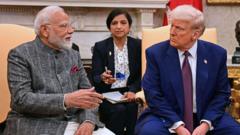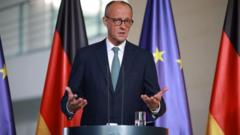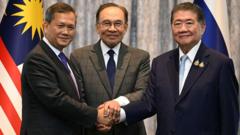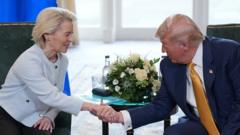Amid ongoing trade negotiations, President Trump indicated that India may be subject to tariffs as high as 25% if an agreement is not finalized this week, highlighting tensions in US-India trade relations.
India Faces Potential 25% Tariffs Amid Trade Negotiations with the US

India Faces Potential 25% Tariffs Amid Trade Negotiations with the US
Trump warns that without a deal by August, India could see tariffs escalate significantly.
In a recent statement, President Donald Trump remarked that India might face tariffs of up to 25% if the country doesn't finalize a trade deal with the United States by the upcoming 1 August deadline. Speaking to reporters, Trump emphasized that while he views India as a "good friend," the nation has imposed higher tariffs than many others, describing it as a "tariff king" and a "big abuser" of trade practices. He noted, "But now I'm in charge, and you just can't do that," underscoring his administration's tough stance on international trade.
US officials have been in negotiations with their Indian counterparts for several months, oscillating between optimism and caution regarding the outcome of discussions. On one hand, Trump has criticized India's trade policies for being excessively protectionist; on the other, negotiations are ongoing, with both sides searching for common ground. When asked for input about the trade talks, US Trade Representative Jamieson Greer described the discussions as constructive but cautioned that India's long-standing protectionist trade policies remain a significant barrier.
Agriculture is at the heart of the negotiations, with the US seeking greater access to India's agricultural markets, which it considers a major opportunity. However, India is committed to protecting its farmers, citing concerns about food security. Indian Commerce Minister Piyush Goyal expressed optimism about the talks, assuring that farmers' interests would be safeguarded.
The US previously announced tariffs of up to 27% on Indian goods, which were temporarily suspended. Nonetheless, there remains a significant trade deficit, with the US aiming to reduce its estimated $45 billion deficit with India. In 2024, bilateral trade between the two nations reached $190 billion, with goals set to double that number to $500 billion.
Both countries continue to work on the key points of contention, with hopes for a pivotal agreement that could reshape their economic relations. Meanwhile, the global community watches closely as the August deadline looms.
US officials have been in negotiations with their Indian counterparts for several months, oscillating between optimism and caution regarding the outcome of discussions. On one hand, Trump has criticized India's trade policies for being excessively protectionist; on the other, negotiations are ongoing, with both sides searching for common ground. When asked for input about the trade talks, US Trade Representative Jamieson Greer described the discussions as constructive but cautioned that India's long-standing protectionist trade policies remain a significant barrier.
Agriculture is at the heart of the negotiations, with the US seeking greater access to India's agricultural markets, which it considers a major opportunity. However, India is committed to protecting its farmers, citing concerns about food security. Indian Commerce Minister Piyush Goyal expressed optimism about the talks, assuring that farmers' interests would be safeguarded.
The US previously announced tariffs of up to 27% on Indian goods, which were temporarily suspended. Nonetheless, there remains a significant trade deficit, with the US aiming to reduce its estimated $45 billion deficit with India. In 2024, bilateral trade between the two nations reached $190 billion, with goals set to double that number to $500 billion.
Both countries continue to work on the key points of contention, with hopes for a pivotal agreement that could reshape their economic relations. Meanwhile, the global community watches closely as the August deadline looms.




















